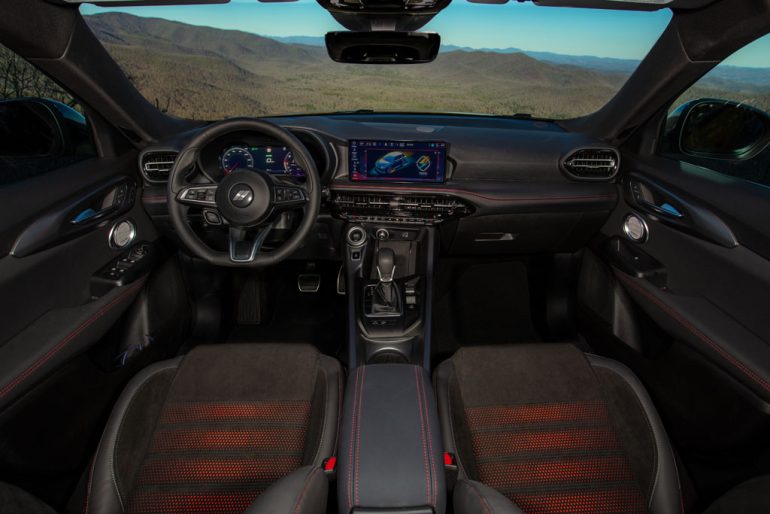
The 2024 Dodge Hornet revives a classic nameplate with a modern twist, reintroducing the Hornet as a sporty subcompact crossover. Sharing its platform with the Alfa Romeo Tonale, the Hornet seamlessly blends Italian design elements with Dodge’s aggressive and bold styling, making it stand out among competitors. With sleek lines, sharp angles, and an overall upscale appearance, it has an almost premium look that some might mistake for a more expensive vehicle like the Porsche Macan, especially from the rear.
Under the hood, the Hornet R/T Plus features a unique plug-in hybrid electric vehicle (PHEV) powertrain that combines a 1.3-liter turbocharged 4-cylinder engine driving the front wheels with an electric motor powering the rear, resulting in all-wheel-drive (EAWD). Together, the system produces up to 288 horsepower and 383 lb-ft of torque, including a special PowerShot mode that adds an extra 30 horsepower for 15 seconds. Activated by pulling both paddle shifters, this boost allows the Hornet R/T to sprint from 0 to 60 mph in just 5.5 seconds, making it one of the peppier options in the subcompact crossover segment.
Also, don’t forget that you can get discounted new car pricing with a free quote through qualified local dealer partners.

While the powertrain is lively, it occasionally struggles with smooth transitions between electric and gasoline power. The 6-speed automatic transmission tends to stay in lower gears, likely to maximize energy recuperation for its 12.0-kWh battery. In doing so, you’re often faced with a somewhat droning sound from the exhaust when idling, which can be nerve racking for some as it isn’t exactly a pleasant sound. When fully charged, the Hornet delivers 32 miles of all-electric range, ideal for short daily commutes with a good amount of torque to power the vehicle without use of the gas engine. However, in hybrid mode, the power delivery can be somewhat unpredictable, and the system lacks the seamless feel that some competitors manage. Still, there’s an e-save mode that preserves battery life or charges the battery while driving, though it impacts fuel economy greatly as you barely ever hit the EPA combined fuel consumption figure of 29 mpg. However, you will hit such and best it if you choose to charge up the Hornet, which is highly recommended to get the most of of such a vehicle.
The Hornet’s quirks in its drivetrain make it challenging for a good overall driving experience, even as it handles pretty good for its class. The suspension setup, though soft in its default mode, gives the vehicle a comfortable ride over most surfaces. However, in Sport mode, the suspension tightens up, enhancing handling but sacrificing energy efficiency. The Hornet R/T comes equipped with Michelin Pilot Sport All-Season 4 tires on 20-inch wheels, which provide excellent grip and a balanced ride, adding to the overall sporty feel where the Hornet really shines.

Inside, the Hornet’s cabin closely mirrors that of the Alfa Romeo Tonale, bringing an Italian-inspired design that feels both modern and practical. Soft-touch materials, accented red stitching, and sporty design elements give the interior an upscale vibe, while the supportive heated front seats ensure comfort during longer drives. The space feels well-utilized for a subcompact crossover, offering a blend of practicality and style.

The Hornet is equipped with a 10.25-inch Uconnect touchscreen infotainment system, which supports both wired and wireless Apple CarPlay and Android Auto. The system works well once you become accustomed to it, though the smaller touchpoints on the screen may frustrate some users initially. The inclusion of a single physical volume knob near the gear shifter adds a touch of old-school functionality, but more physical controls would be welcome for easier access to frequently used features.

The seating areas up front are seemingly narrow for your knee area as taller occupants may find their legs digging into the side door trim and center tunnel. Otherwise, the heated alcantara front seats prove to be supportive and not overly uncomfortable on long trips.

Cargo space is average for the segment, with 23 cubic feet of space behind the rear seats, expanding to 51 cubic feet with the 60/40-split rear seat backs folded down. Accessing the cargo area is easy and straightforward through use of the power liftgate.
In terms of safety, the Dodge Hornet R/T Plus comes well-equipped with a range of advanced active driver assistance features. The tech package includes essentials like adaptive cruise control, lane-keep assist, blind-spot monitoring, and forward collision warning with emergency braking. The 360-degree surround-view camera system is also a handy addition for tight parking situations.

Pricing for the Hornet R/T Plus PHEV starts at around $46,745 and just $31400 for the base non-hybrid GT trim, but with all the bells and whistles on my test vehicle—such as the Track pack, Tech pack, and Blacktop package—pushing the price to around $54,325 as-tested, it’s one of the more expensive options in its class making it a hard sell, which may be reflected in the recent slow sales of the Hornet. Despite the premium price, the Hornet still delivers a lot of value with its advanced plug-in hybrid system, strong performance, and upscale features. For buyers seeking a blend of sportiness, efficiency, and versatility in a subcompact crossover, the 2024 Dodge Hornet R/T Plus is a solid contender that may still be unnoticed by many.